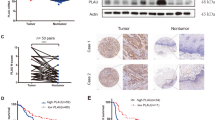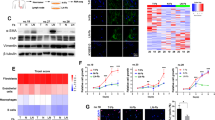Abstract
Various factors and cellular components in the tumor microenvironment are key drivers associated with drug resistance in many cancers. Here, we analyzed the factors and molecular mechanisms involved in chemoresistance in patients with esophageal squamous cell carcinoma (ESCC). We found that interleukin 6 (IL6) derived mainly from cancer-associated fibroblasts played the most important role in chemoresistance by upregulating C-X-C motif chemokine receptor 7 (CXCR7) expression through signal transducer and activator of transcription 3/nuclear factor-κB pathway. CXCR7 knockdown resulted in the inhibition of IL6-induced proliferation and chemoresistance. In addition, CXCR7 silencing significantly decreased gene expression associated with stemness, chemoresistance and epithelial–mesenchymal transition and suppressed the proliferation ability of ESCC cells in three-dimensional culture systems and angiogenesis assay. In clinical samples, ESCC patients with high expression of CXCR7 and IL6 presented a significantly worse overall survival and progression-free survival upon receiving cisplatin after operation. These results suggest that the IL6–CXCR7 axis may provide a promising target for the treatment of ESCC.
This is a preview of subscription content, access via your institution
Access options
Subscribe to this journal
Receive 50 print issues and online access
$259.00 per year
only $5.18 per issue
Buy this article
- Purchase on Springer Link
- Instant access to full article PDF
Prices may be subject to local taxes which are calculated during checkout






Similar content being viewed by others
Change history
18 September 2023
A Correction to this paper has been published: https://doi.org/10.1038/s41388-023-02822-3
References
Holohan C, Van Schaeybroeck S, Longley DB, Johnston PG . Cancer drug resistance: an evolving paradigm. Nat Rev Cancer 2013; 13: 714–726.
McMillin DW, Negri JM, Mitsiades CS . The role of tumour-stromal interactions in modifying drug response: challenges and opportunities. Nat Rev Drug Discov 2013; 12: 217–228.
Morin PJ . Drug resistance and the microenvironment: nature and nurture. Drug Resist Updat 2003; 6: 169–172.
Shi WJ, Gao JB . Molecular mechanisms of chemoresistance in gastric cancer. World J Gastrointest Oncol 2016; 8: 673–681.
Velaei K, Samadi N, Barazvan B, Soleimani Rad J . Tumor microenvironment-mediated chemoresistance in breast cancer. Breast 2016; 30: 92–100.
Villanueva MT . Cell signalling: Stuck in the middle of chemoresistance and metastasis. Nat Rev Clin Oncol 2012; 9: 490.
Wilson BJ, Saab KR, Ma J, Schatton T, Putz P, Zhan Q et al. ABCB5 maintains melanoma-initiating cells through a proinflammatory cytokine signaling circuit. Cancer Res 2014; 74: 4196–4207.
Park YH, Sohn SK, Kim JG, Lee MH, Song HS, Kim MK et al. Interaction between BCL2 and interleukin-10 gene polymorphisms alter outcomes of diffuse large B-cell lymphoma following rituximab plus CHOP chemotherapy. Clin Cancer Res 2009; 15: 2107–2115.
Heinecke JL, Ridnour LA, Cheng RY, Switzer CH, Lizardo MM, Khanna C et al. Tumor microenvironment-based feed-forward regulation of NOS2 in breast cancer progression. Proc Natl Acad Sci USA 2014; 111: 6323–6328.
Bid HK, Kibler A, Phelps DA, Manap S, Xiao L, Lin J et al. Development, characterization, and reversal of acquired resistance to the MEK1 inhibitor selumetinib (AZD6244) in an in vivo model of childhood astrocytoma. Clin Cancer Res 2013; 19: 6716–6729.
Korkaya H, Liu S, Wicha MS . Regulation of cancer stem cells by cytokine networks: attacking cancer's inflammatory roots. Clin Cancer Res 2011; 17: 6125–6129.
Alas S, Emmanouilides C, Bonavida B . Inhibition of interleukin 10 by rituximab results in down-regulation of bcl-2 and sensitization of B-cell non-Hodgkin's lymphoma to apoptosis. Clin Cancer Res 2001; 7: 709–723.
Vandercappellen J, Van Damme J, Struyf S . The role of CXC chemokines and their receptors in cancer. Cancer Lett 2008; 267: 226–244.
Balkwill FR . The chemokine system and cancer. J Pathol 2012; 226: 148–157.
Hartmann TN, Burger JA, Glodek A, Fujii N, Burger M . CXCR4 chemokine receptor and integrin signaling co-operate in mediating adhesion and chemoresistance in small cell lung cancer (SCLC) cells. Oncogene 2005; 24: 4462–4471.
Calinescu AA, Yadav VN, Carballo E, Kadiyala P, Tran D, Zamler DB et al. Survival and proliferation of neural progenitor-derived glioblastomas under hypoxic stress is controlled by a CXCL12/CXCR4 autocrine-positive feedback mechanism. Clin Cancer Res 2017; 23: 1250–1262.
Gil M, Seshadri M, Komorowski MP, Abrams SI, Kozbor D . Targeting CXCL12/CXCR4 signaling with oncolytic virotherapy disrupts tumor vasculature and inhibits breast cancer metastases. Proc Natl Acad Sci USA 2013; 110: E1291–E1300.
Muller A, Homey B, Soto H, Ge N, Catron D, Buchanan ME et al. Involvement of chemokine receptors in breast cancer metastasis. Nature 2001; 410: 50–56.
Pennathur A, Gibson MK, Jobe BA, Luketich JD . Oesophageal carcinoma. Lancet 2013; 381: 400–412.
Enzinger PC, Mayer RJ . Esophageal cancer. N Engl J Med 2003; 349: 2241–2252.
Schweigert M, Dubecz A, Stein HJ . Oesophageal cancer—an overview. Nat Rev Gastroenterol Hepatol 2013; 10: 230–244.
Demeester SR . Reoperative chemoradiotherapy for oesophageal cancer: a systematic review and meta-analysis. Gut 2005; 54: 440–441.
Wang LH, Yang XY, Zhang X, Huang J, Hou J, Li J et al. Transcriptional inactivation of STAT3 by PPARgamma suppresses IL-6-responsive multiple myeloma cells. Immunity 2004; 20: 205–218.
Smith MR, Xie T, Joshi I, Schilder RJ . Dexamethasone plus retinoids decrease IL-6/IL-6 receptor and induce apoptosis in myeloma cells. Br J Haematol 1998; 102: 1090–1097.
Hattermann K, Held-Feindt J, Lucius R, Muerkoster SS, Penfold ME, Schall TJ et al. The chemokine receptor CXCR7 is highly expressed in human glioma cells and mediates antiapoptotic effects. Cancer Res 2010; 70: 3299–3308.
Lippitz BE, Harris RA . Cytokine patterns in cancer patients: a review of the correlation between interleukin 6 and prognosis. Oncoimmunology 2016; 5: e1093722.
Baggiolini M . Chemokines and leukocyte traffic. Nature 1998; 392: 565–568.
Duda DG, Kozin SV, Kirkpatrick ND, Xu L, Fukumura D, Jain RK . CXCL12 (SDF1alpha)-CXCR4/CXCR7 pathway inhibition: an emerging sensitizer for anticancer therapies? Clin Cancer Res 2011; 17: 2074–2080.
Kojima Y, Acar A, Eaton EN, Mellody KT, Scheel C, Ben-Porath I et al. Autocrine TGF-beta and stromal cell-derived factor-1 (SDF-1) signaling drives the evolution of tumor-promoting mammary stromal myofibroblasts. Proc Natl Acad Sci USA 2010; 107: 20009–20014.
Sun X, Cheng G, Hao M, Zheng J, Zhou X, Zhang J et al. CXCL12 / CXCR4 / CXCR7 chemokine axis and cancer progression. Cancer Metastasis Rev 2010; 29: 709–722.
Teicher BA, Fricker SP . CXCL12 (SDF-1)/CXCR4 pathway in cancer. Clin Cancer Res 2010; 16: 2927–2931.
Sierro F, Biben C, Martinez-Munoz L, Mellado M, Ransohoff RM, Li M et al. Disrupted cardiac development but normal hematopoiesis in mice deficient in the second CXCL12/SDF-1 receptor, CXCR7. Proc Natl Acad Sci USA 2007; 104: 14759–14764.
Miao Z, Luker KE, Summers BC, Berahovich R, Bhojani MS, Rehemtulla A et al. CXCR7 (RDC1) promotes breast and lung tumor growth in vivo and is expressed on tumor-associated vasculature. Proc Natl Acad Sci USA 2007; 104: 15735–15740.
Zhao S, Chang SL, Linderman JJ, Feng FY, Luker GD . A comprehensive analysis of CXCL12 isoforms in breast cancer1,2. Transl Oncol 2014; 7: 429–438.
Tachezy M, Zander H, Gebauer F, von Loga K, Pantel K, Izbicki JR et al. CXCR7 expression in esophageal cancer. J Transl Med 2013; 11: 238.
Wu K, Cui L, Yang Y, Zhao J, Zhu D, Liu D et al. Silencing of CXCR2 and CXCR7 protects against esophageal cancer. Am J Transl Res 2016; 8: 3398–3408.
Darash-Yahana M, Pikarsky E, Abramovitch R, Zeira E, Pal B, Karplus R et al. Role of high expression levels of CXCR4 in tumor growth, vascularization, and metastasis. FASEB J 2004; 18: 1240–1242.
Hinton CV, Avraham S, Avraham HK . Role of the CXCR4/CXCL12 signaling axis in breast cancer metastasis to the brain. Clin Exp Metastasis 2010; 27: 97–105.
Liu J, Liao S, Huang Y, Samuel R, Shi T, Naxerova K et al. PDGF-D improves drug delivery and efficacy via vascular normalization, but promotes lymphatic metastasis by activating CXCR4 in breast cancer. Clin Cancer Res 2011; 17: 3638–3648.
Goto M, Yoshida T, Yamamoto Y, Furukita Y, Inoue S, Fujiwara S et al. CXCR4 expression is associated with poor prognosis in patients with esophageal squamous cell carcinoma. Ann Surg Oncol 2017; 24: 832–840.
Zhang L, Ye SB, Ma G, Tang XF, Chen SP, He J et al. The expressions of MIF and CXCR4 protein in tumor microenvironment are adverse prognostic factors in patients with esophageal squamous cell carcinoma. J Transl Med 2013; 11: 60.
Lin L, Han MM, Wang F, Xu LL, Yu HX, Yang PY . CXCR7 stimulates MAPK signaling to regulate hepatocellular carcinoma progression. Cell Death Dis 2014; 5: e1488.
Jin Z, Nagakubo D, Shirakawa AK, Nakayama T, Shigeta A, Hieshima K et al. CXCR7 is inducible by HTLV-1 Tax and promotes growth and survival of HTLV-1-infected T cells. Int J Cancer 2009; 125: 2229–2235.
Kerdivel G, Boudot A, Pakdel F . Estrogen represses CXCR7 gene expression by inhibiting the recruitment of NFkappaB transcription factor at the CXCR7 promoter in breast cancer cells. Biochem Biophys Res Commun 2013; 431: 729–733.
Liu FY, Zhao ZJ, Li P, Ding X, Guo N, Yang LL et al. NF-kappaB participates in chemokine receptor 7-mediated cell survival in metastatic squamous cell carcinoma of the head and neck. Oncol Rep 2011; 25: 383–391.
Tarnowski M, Grymula K, Reca R, Jankowski K, Maksym R, Tarnowska J et al. Regulation of expression of stromal-derived factor-1 receptors: CXCR4 and CXCR7 in human rhabdomyosarcomas. Mol Cancer Res 2010; 8: 1–14.
Tarnowski M, Liu R, Wysoczynski M, Ratajczak J, Kucia M, Ratajczak MZ . CXCR7: a new SDF-1-binding receptor in contrast to normal CD34(+) progenitors is functional and is expressed at higher level in human malignant hematopoietic cells. Eur J Haematol 2010; 85: 472–483.
Wu YC, Tang SJ, Sun GH, Sun KH . CXCR7 mediates TGFbeta1-promoted EMT and tumor-initiating features in lung cancer. Oncogene 2016; 35: 2123–2132.
Acknowledgements
This study was supported by grants from the National Natural Science Foundation of China (Grant No. 81171986), Research Grant from the Ministry of Public Health (Grant No. 201501004) and the Basic and Advanced Technology Research Foundation from Science and Technology Department of Henan Province (Grant Nos. 112300410153 and 122300410155).
Author information
Authors and Affiliations
Corresponding author
Ethics declarations
Competing interests
The authors declare no conflict of interest.
Additional information
Supplementary Information accompanies this paper on the Oncogene website
Rights and permissions
About this article
Cite this article
Qiao, Y., Zhang, C., Li, A. et al. IL6 derived from cancer-associated fibroblasts promotes chemoresistance via CXCR7 in esophageal squamous cell carcinoma. Oncogene 37, 873–883 (2018). https://doi.org/10.1038/onc.2017.387
Received:
Revised:
Accepted:
Published:
Issue Date:
DOI: https://doi.org/10.1038/onc.2017.387
This article is cited by
-
Integrative analysis of bulk and single-cell gene expression profiles to identify tumor-associated macrophage-derived CCL18 as a therapeutic target of esophageal squamous cell carcinoma
Journal of Experimental & Clinical Cancer Research (2023)
-
Global cluster analysis and network visualization in cancer-associated fibroblast: insights from Web of Science database from 1999 to 2021
European Journal of Medical Research (2023)
-
Advances in the structure, mechanism and targeting of chemoresistance-linked ABC transporters
Nature Reviews Cancer (2023)
-
CXCR7 as a novel therapeutic target for advanced prostate cancer
Oncogene (2023)
-
The critical role of circular RNAs in drug resistance in gastrointestinal cancers
Medical Oncology (2023)



